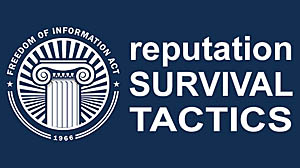


How Your Reputation Can Survive Media Public Records Requests
By Howard Fencl, Hennes Communications…
Public record requests can be complex and time-consuming. In many instances you need to drop everything you’re doing and launch a scavenger hunt through voluminous caches of electronic and paper records across a number of different departments to fulfill the reporter’s request. Yes, it may be frustrating, and it may be a grind. It’s also your job and it’s always worth remembering that these records belong to the public – you know, those folks paying your salary.
Open records laws vary somewhat from state to state, but the bottom line is that anyone – not just the media – can request public records from any government agency at any level. Increasingly, especially in this social media era, private citizens are making public record requests – and now with the ability to publish to potentially thousands of people via Facebook, Twitter and other channels how that process went and what was found. And if you think you’re in the clear because you’re a private business, read on! Because if you’re contracted to do work for a government office, records related to that work may be considered public records, even if they only live on your hard drive or in your office’s file cabinets.
We’d recommend always following the best practices of prompt response and a real willingness to fulfill the request – again, these records belong to the public. And when you’re dealing with a news media request, here are some important reputational do’s and don’ts:
Do acknowledge the request
In Ohio, where our offices are based, public entities need to acknowledge receiving an open records request within three days. But it’s a good idea to answer the same day, particularly if the reporter has not shared a deadline with you. Acknowledge the request, ask for a deadline, and explain how long it will take to fulfill the request.
If the reporter shoots back an email giving you an unreasonable deadline, it’s time to negotiate. Call the reporter on the phone (you do remember how to make a phone call, yes?) and explain that the deadline is unreasonable given the scope of the request. Don’t prevaricate – truthfully explain the bureaucratic process you have to go through, the departments you need to engage to help fulfill the request and reiterate the time you need to put all the information together. Can the reporter push back the deadline?
If the answer is “no,” ask them to refine the scope of the request. If the reporter declines, ask to speak to an editor, and go through this process again.
Do ask what the story is about
The reporter may tell you the focus of the investigation in the initial records request. Or not. Reporters do not have to reveal why they are asking for public records, but it is certainly your right to ask what the story is about. You may have additional records outside the scope of the request that helps clarify your organization’s actions relative to the reporter’s investigation.
Don’t release without legal
Your legal team should review all public records before release. Redactions may be necessary. Some documents may be subject to attorney-client privilege or constitute confidential law enforcement investigative records and should not be released. Your transmittal email to the reporter should point out that there are privileged omissions or redactions, and why redactions were necessary – personal information is commonly redacted to protect privacy, for example. Explaining omissions and redactions can help mitigate a reporter’s temptation to use a document riddled with black marker cross-outs as a dramatic prop in a news story.
Don’t obfuscate
If your records search turns up damning information, don’t try to hide it by over-responding to the reporter’s request with mountains of information. Any skilled reporter will still find the damning nugget and trumpet it in the story. If you give the media a pile of superfluous information to hide a troublesome issue, expect it to be portrayed as a cover-up. Better to rip off the Band-Aid® and give the reporter the back story – what happened, why did it happen, who knew about it and what your organization did about it.
Do provide context
You can’t email reporters a pile of information and assume they will draw the same conclusions that you do. Providing a brief, bulleted executive summary of the data you are providing in your transmittal email sets context for the reporter. It may help shape the structure of the story or lead the reporter to present content more favorable to your organization than if you simply send an email attachment with a scant cover note. The caveat here, of course, is that your summary must be transparent and truthful, warts and all, or you risk being caught in a lie. That’s a label no one wants – a label that can destroy your reputation and that of your organization. Why risk the trust you and your colleagues have worked so hard to build?